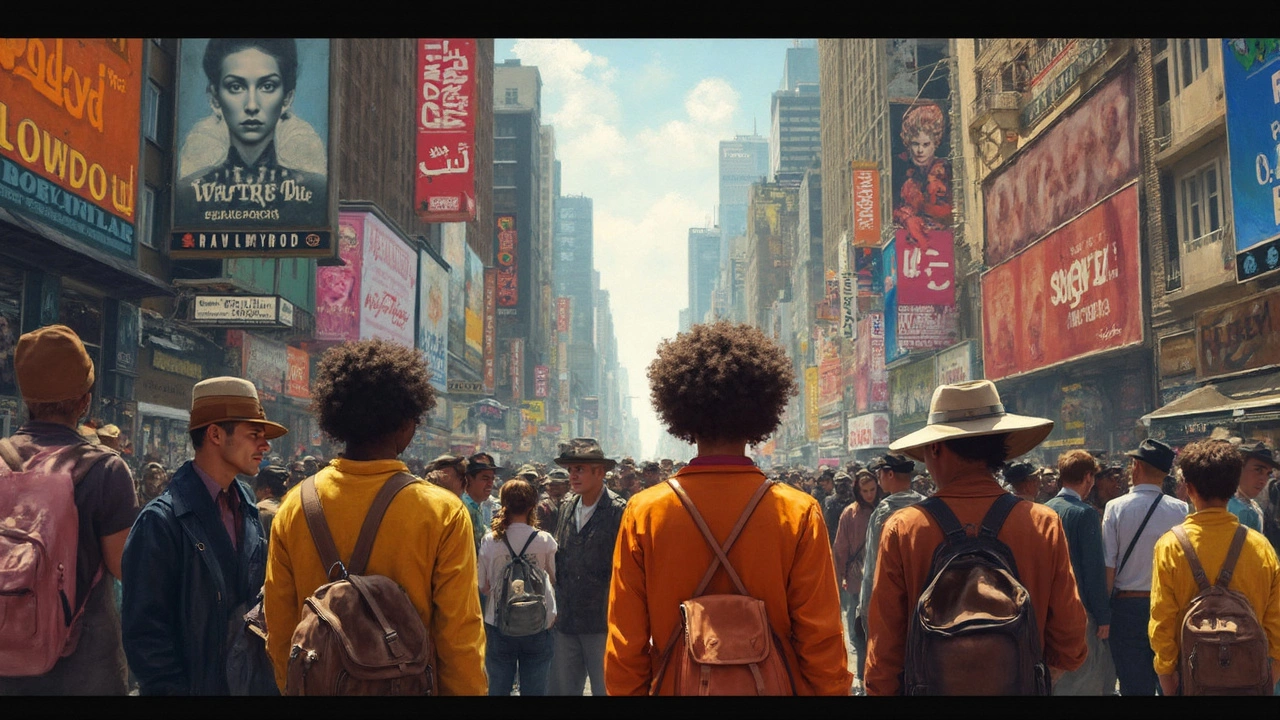Dominant Culture in the United States: Who Really Sets the Tone?
 Jun, 15 2025
Jun, 15 2025
Ask ten people who calls the cultural shots in the US, and you'll get a bunch of different answers. Some point straight to Hollywood or Wall Street, others mention schools or tech giants. But it’s not just about money or fame—it's about who gets to decide what's normal, what's cool, and what gets passed down.
There's no single group running the show all the time. Most of the big traditions and values that pop up in movies, ads, or even holiday sales still have deep links to European—and especially Anglo—roots. Think English as the main language, Christmas as a huge holiday, and baseball and apple pie in the mix. But that's only half the story. Music, food, and slang in the States have always borrowed from African American communities, Latinx traditions, Asian pop culture, and more. Even the idea of the “melting pot” is way more complicated than it sounds.
So, who counts as the dominant culture right now? Depends on what you’re looking at. Legally and in big institutions like politics or education, white, English-speaking Americans still hold a lot of the cards. That shows up in everything from how textbooks are written to what's served in the school cafeteria. But if you flip on TikTok or look at trends in fashion or food, you'll see how quickly things shift and blend.
- Defining Dominance in Culture
- American Mainstream: History and Today
- How Minority Cultures Shape and Resist
- Navigating Everyday Culture Wars
Defining Dominance in Culture
So, what does it really mean when we talk about "dominant culture" in the United States? In simple terms, it's about whose customs, values, and behaviors get treated like the default—the stuff that most people see as "normal." The dominant culture is the one steering the bus, deciding what's polite, what holidays get days off, and what's shown in mainstream media.
In the U.S., this usually lines up with the group that holds the most power in government, business, and the media. Historically, that's been white, English-speaking Americans, mostly with European heritage. This shows up everywhere, from the language used in courtrooms to which sports are shown on national TV.
But dominance isn’t just about numbers. Sometimes, a group that isn’t the biggest by population still sets the cultural tone if they’ve got economic or political power. A quick look at U.S. presidential history makes this clear—45 out of 46 presidents so far have been white men of European descent.
Cultural dominance also creeps in through schools, legal systems, and even daily routines. Think about when kids learn to pledge allegiance in English, or why so many businesses close on Christmas but not on Lunar New Year or Eid. These choices reflect values from the dominant group and tend to stick over generations.
Here’s a simple breakdown of how cultural dominance works in the U.S.:
- Language: English runs the show—in everything from government documents to entertainment.
- Holidays: Most national holidays match Christian or European-origin dates.
- Media Representation: TV shows and movies often center on white, middle-class families and downplay others’ stories.
- Education: Textbooks focus a lot on European history and Western perspectives.
It’s not all just tradition—there’s real impact. For example, according to a 2023 Pew Research survey, about 63% of Americans think it's important to speak English to be "truly American." That tells you how deep the language ties run.
| Area | Dominant U.S. Norm | Alternative Examples |
|---|---|---|
| Language | English | Spanish, Chinese, Tagalog |
| Religious Holidays | Christmas, Easter | Hanukkah, Ramadan, Diwali |
| Food | Burgers, Pizza, Fried Chicken | Tacos, Pho, Sushi |
| Media Focus | White, Middle-Class Stories | Black, Asian, Latino stories gaining traction |
Knowing these facts helps you spot when the dominant culture is at work—and when things are starting to change. If you want to make sense of American life, you’ve got to know who’s driving the stereotype bus.
American Mainstream: History and Today
The idea of a mainstream culture in the United States goes back to the country's early days. British, German, Irish, and other mostly white European immigrants made up the bulk of the population in the 1800s. They brought the language, holidays, and habits that would set the tone for public life. By 1960, about 85% of Americans identified as white and mostly spoke English at home. That’s where you get the standard school calendar set around Christmas and Thanksgiving, for example.
For decades, mainstream American identity leaned hard on the image of the "average Joe"—white, middle class, English-speaking, and Christian. TV shows like "Leave It to Beaver" or "Friends" stuck with these themes. But starting in the late 1960s, things began to change fast. Civil rights movements pushed for more inclusion. Immigration laws loosened up, and by 2020, about 40% of Americans identified with a group other than non-Hispanic white, according to the census.
Today, it’s a wild mix. What’s considered the "mainstream" still features old-school traditions, but newer influences are everywhere. For example, dominant culture still shows up in politics and big businesses, but hip hop, Latin music, and Asian pop culture now shape what people watch, wear, and eat.
| Year | Non-Hispanic White (%) | Hispanic (%) | Black or African American (%) | Asian (%) |
|---|---|---|---|---|
| 1960 | 85.0 | 3.5 | 10.5 | 0.5 |
| 2000 | 69.1 | 12.5 | 12.3 | 3.6 |
| 2020 | 59.3 | 18.7 | 12.1 | 5.9 |
We see this diversity in everything from YouTube trends to school lunch options. While laws and schools still reflect the old mainstream, the day-to-day reality is a cultural mashup. If you want to fit in or understand what’s going on in the US, you can’t just follow old rules—you’ve got to keep up with what’s popular and what’s changing.

How Minority Cultures Shape and Resist
Minority communities in the US don’t just join the party—they help run it, remix it, and sometimes push back big time. Look anywhere: hip-hop, which started in the Bronx in the 1970s, exploded into a global movement because Black and Latino youth made their own rules. You see the same with food. Tacos and sushi went from neighborhood specialties to all-American favorites you’d find almost everywhere. In the 2020 Census, Latinos made up 19% of the population and Asian Americans hit a record 7%—that’s no small impact on the country’s identity.
Shaping dominant culture happens in lots of ways, like:
- Pop culture: Black creators set music and fashion trends. K-Pop groups like BTS draw massive American followings. Latino actors and artists headline major awards.
- Tech and inventing: Immigrants have started more than half of America’s unicorn startups in the last decade.
- Politics and social movements: The Black Lives Matter protests in 2020 pushed reforms and forced new national conversations about race and policing.
- Food and celebrations: Lunar New Year, Diwali, and Ramadan are now on many school calendars.
Resistance is just as real. Sometimes, minority groups say no to blending in—or choose what to keep and what to let go. For example, there’s a strong movement to preserve native languages among Indigenous tribes, even though less than 1% now speak them fluently. Juneteenth, once a mostly local Texas tradition, is now a federal holiday—pushed by decades of activism. Bilingual education has been a hot debate for years, and families fight to keep their home languages alive at kitchen tables and in Saturday schools.
Here are some numbers that show this push and pull:
| Group/Event | Impact/Stat |
|---|---|
| Black Lives Matter Protests (2020) | 15-26 million Americans, across all backgrounds, joined marches—the largest movement in US history |
| K-Pop Fandom in US | BTS had five No. 1 singles on the Billboard Hot 100 in two years (2020-22) |
| Latino Food Market | $21 billion yearly spend on Latino foods by American shoppers (Nielsen, 2023) |
| Indigenous Language Revitalization | About 20% of Navajo youth now enrolled in bilingual education programs (National Indian Education Study, 2022) |
If you want to support or learn from minority cultures, here are some tips:
- Don’t just ‘try’ the food—go to local festivals, support minority-owned businesses, or tune in to authentic music, film, and books.
- Ask questions with respect. Most folks love sharing their stories, just don’t assume you know it all.
- If you’re a parent, check if your child’s school celebrates diverse histories and languages. If not, ask for change—it works.
- Keep your ears open on social media. You’ll spot trends and voices here way before they hit the mainstream.
Navigating Everyday Culture Wars
The phrase “culture wars” gets thrown around a lot, but it’s about more than just people yelling online. These debates show up right where most of us live—schools, workplaces, grocery stores, and even what we watch on TV. Hot topics range from what books kids should read in class, to how we talk about race, gender, and immigration. For example, in the last few years, more than 30 U.S. states introduced laws on classroom discussions of racism, with heated arguments from all sides. When big retail companies change ads or products to reflect diversity—like making Barbie dolls of different skin colors—there’s an outpouring of both support and backlash.
Some folks feel like their traditions are being left behind or replaced; others are frustrated that change isn’t happening fast enough. This tension plays out even over food and language. Ever noticed how calling something “authentic” gets people fired up? Just look at debates over whether pineapple belongs on pizza, or whether it’s disrespectful to tweak traditional dishes. This isn’t just petty drama—it touches on who gets to define what’s ‘normal’ for everyone else.
If you’re trying to make sense of these dominant culture battles, here are a few ways to keep your sanity and stay informed:
- Look for context before reacting—ask yourself who benefits if things change, and who loses out.
- Get news from more than one source, especially if it reports on cultural issues or protest movements.
- Listen before getting loud. Sometimes folks aren’t mad about what you think—they might just feel ignored.
- Remember, just because something feels new or odd doesn’t make it a threat. A lot of what seems “controversial” today was fought over in the past, from jazz music to blue jeans.
Culture wars aren't going away. But being open about your questions, and paying attention to how these battles shape daily life, can help you filter out the noise from what really matters.